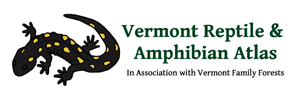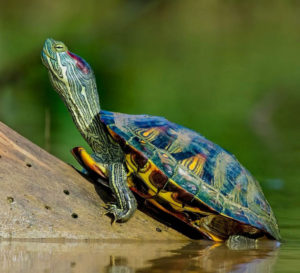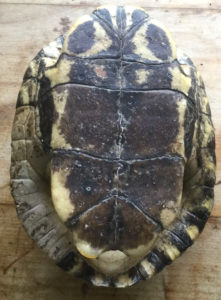Trachemys scripta
Identification
The Pond Slider is a turtle native to the southeastern US. The Red-eared Slider (Trachemys scripta elegans) is a particularly attractive subspecies of Pond Slider that has a wide dark-red stripe behind each eye. This subspecies is the most frequently sold aquatic turtle in the pet trade. Since it is very long-lived and gets large, owners often tire of them and release them into the wild. This is a bad idea, since released turtles may introduce foreign diseases to our native turtles, and they compete with our native turtles for habitat. Red-eared Sliders have colonized many areas outside their native range. It is a medium-sized turtle, growing to about 11 inches carapace length (larger than our native Painted Turtles).
The Red-eared Slider has yellow- or cream-colored stripes on its neck and legs (similar to two of our native turtle species, see below); however, it also has a wide red stripe behind each eye. The greenish-gray to brown carapace is oval and slightly domed, with a weak keel. The posterior margin (rear edge) of the carapace is weakly serrated (toothed). The plastron is yellow, often with a dark blotch in the center of each scute. Males can be melanistic, and most males and some females darken as they age.
Similar Native Species
Painted Turtles have red stripes at the base of their necks and on their tails and legs (the slider does not) and red on their marginal scutes (yellow on the slider). Painted Turtles do not have a red stripe behind their eyes (the slider does), and the posterior margin of Painted Turtles’ shells is smooth all the way around (weakly serrated in sliders). Painted Turtles’ carapace also tends to look shiny black from a distance (as opposed to greenish-gray/brown in the Red-eared Slider).
Northern Map Turtles’ carapaces have a strong central keel (weak in sliders) and a strongly toothed posterior margin (weakly serrated in sliders). Northern Map Turtles do not have a red stripe behind their eyes, nor red anywhere else on their bodies.
You can learn more about Red-eared Sliders and see some video footage by checking out the video clip from our Rattlers, Peepers & Snappers DVD.
Range/Habitat

[ click image to zoom | download printable PDF ]

[ click image to zoom | download printable PDF ]
The Pond Slider is native to the southeastern and midwestern US. In Vermont, we have scattered reports of individuals from seven counties (sixteen towns), where they are presumed to be released pets.
Red-eared Sliders spend much of their time basking in the sun on rocks, logs, and shorelines; however, they are also capable of moving over land. They prefer still, warm, and shallow water with a mucky bottom, and lots of emergent vegetation.
Status
The Red-eared Slider is a popular pet turtle that is often released into the wild, and is considered an unconfirmed species in Vermont, but also one that might become invasive (a non-native species whose introduction causes or is likely to cause economic or environmental harm).
The species is considered invasive in 64 countries, including the US. It competes with native species for food, nesting areas, and basking spots. It may also transmit parasites and diseases to native turtles.
Alaska, New Hampshire, and Vermont are the only states that do not currently have known breeding populations. However, as a result of climate change, the Red-eared Slider could become established in Vermont.
We track reports of this species and are concerned about its potential impact to native species.
Please do not buy sliders from stores, or release pet turtles into the wild. You may instead be able to adopt a slider from someone who can no longer care for theirs.
Please report all suspected sightings of this species in Vermont. Take photos if possible.
Additional Photos & Video
Click on a photo to see it larger.
More Info
- Trachemys scripta at Animal Diversity website
- Trachemys scripta in Nonindigenous Aquatic Species Database, U.S. Geological Survey
- Red-eared sliders and native turtles from The Orianne Society
Species summary written by Kate Kelly and Matt Gorton.






